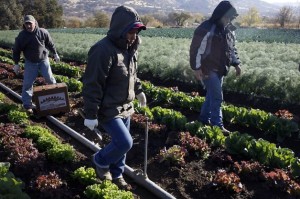New FDA Law and Salinas Valley Farmers 11/25/13
Washington — In the seven years since an E. coli outbreak caused by contaminated bagged spinach from Central California left five dead and 103 hospitalized, retailers and other large buyers have forced Salinas Valley farmers to rip out wildlife habitat, fence fields, poison rodents and scrape away native vegetation – all in the name of food safety.
On Friday, the Food and Drug Administration closed public comment on 1,200 pages of proposed rules for farms and processors that would implement the Food Safety Modernization Act, which Congress passed three years after the 2007 outbreak. Critics say the rules would lead farms across the country to adopt tactics that they maintain have ravaged the Salinas Valley, erased billions of dollars of taxpayer investments in farm conservation, overridden organic farming protocols and damaged local food systems.
“We’re really concerned that what happened on the Central Coast is going to translate nationwide” if the federal rules go into effect, said Jo Ann Baumgartner, director of the Wild Farm Alliance, a sustainable-farming group in Watsonville.
The proposal has ignited fury in the local and organic farm movement, and a stout defense from food poisoning victims groups. Almost 20,000 comments were filed in response to the proposed rules, which are scheduled to take effect in 2015.
‘Prevention-based’
The Food and Drug Administration called the new rules “the cornerstone of the prevention-based, modern food safety system we need.”
The 548-page rule for produce farms regulates the use of irrigation water, compost and manure, hygiene and training for workers, wildlife intrusion and other areas. As one example, if bird excreta were found on a head of lettuce, it could not be harvested.
Seattle trial lawyer Bill Marler, who represented victims of the spinach outbreak, said the rules will “protect farmers from poisoning a bunch of people and getting sued by a guy like me.”
But Tom Willey, who with his wife owns T&D Willey Farms, a 75-acre organic farm in the San Joaquin Valley, said federal officials are adopting a “sterility paradigm” that tries to sanitize farms and ignores evidence that healthy soils, vegetative buffers and other organic techniques help remove pathogens from plants.
“There’s very little recognition of the newest science that recognizes that highly diverse microbial communities are very protective of our health,” Willey said.
The biggest danger to consumers, he argued, lies not on the farm but after harvest, when big processors cut, wash and package produce that then sits two weeks or longer while being “shipped 3,000 miles in a microbial incubator bag.”
The contaminated bagged spinach that prompted the proposed rules came from a farm near San Juan Bautista in San Benito County. Feral pigs intruding into the field were suspected, but the source of the E .coli 0157:H7 infection was never identified.
The outbreak cost the leafy greens industry hundreds of millions of dollars in sales and litigation costs. Large buyers imposed their own safety standards, sending out private inspectors who encouraged farmers to erect fences, drain ponds, poison mammals, scrape buffers around crops and even put up frog barriers – anything that was thought to prevent wildlife intrusions.
Andy Gordus, a toxicologist at the California Department of Fish and Wildlife, said subsequent studies showed wildlife is an insignificant source of the lethal E. coli strain implicated in the spinach outbreak. But buyers were in a “panic,” he said, and came up with their own rules.
California growers responded with their own voluntary protocols that were less drastic, but Gordus and others said many of the buyer rules remain in effect.
Congress ordered the Food and Drug Administration to avoid conflicts with the organic standard, which requires four months between application of manure and harvest. The agency would require nine months, slashing growing seasons, and add a 45-day waiting period after applying compost.
